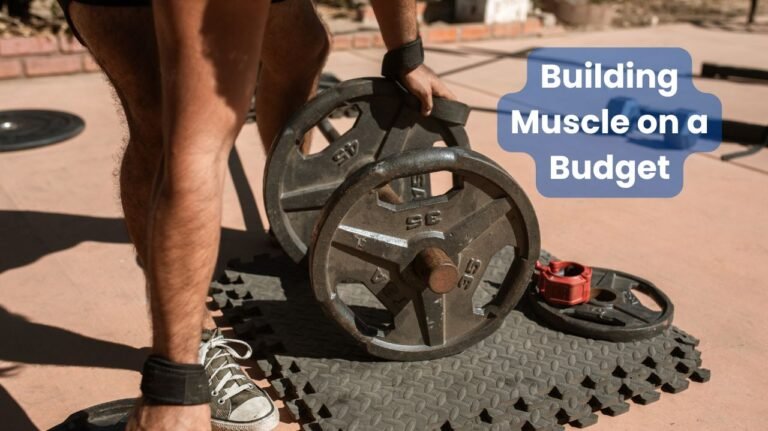How to Break Through a Muscle-Building Plateau
For fitness enthusiasts and bodybuilders, few things are as frustrating as hitting a muscle-building plateau. After months of consistent progress, suddenly the gains seem to grind to a halt.
The weights aren’t increasing, muscles aren’t growing, and motivation starts to wane. But fear not – plateaus are a normal part of any fitness journey, and with the right strategies, they can be overcome.
This article will explore various techniques and approaches to help break through a muscle-building plateau. From adjusting training programs to fine-tuning nutrition, we’ll cover everything needed to reignite muscle growth and get back on track to achieving fitness goals.
👉 Pack On Muscle Mass and Get Bigger and Stronger
👉 Burn Fat and Get Seriously Ripped
👉 Get Explosive Strength and Maximum Stamina
👉 Become A Gym Beast With Legal SARMs Alternatives
Understanding Muscle-Building Plateaus
Before diving into solutions, it’s essential to understand what causes muscle-building plateaus. When someone first starts a resistance training program, their body responds quickly to the new stimulus. This period, often referred to as “newbie gains,” is characterized by rapid strength increases and muscle growth.
However, as the body adapts to the training stimulus, the rate of progress naturally slows down. This adaptation is a normal physiological process, but it can lead to plateaus if the training program isn’t adjusted accordingly. Some common reasons for hitting a plateau include:
- Lack of progressive overload
- Insufficient recovery time
- Inadequate nutrition
- Monotonous training routines
- Overtraining
- Hormonal factors
Recognizing these potential causes is the first step in developing a strategy to overcome a plateau.
Strategies to Break Through a Muscle-Building Plateau
1. Implement Progressive Overload
Progressive overload is the gradual increase of weight, frequency, or number of repetitions in a strength training program. It’s the foundation of continued muscle growth and strength gains. To break through a plateau, consider the following progressive overload techniques:
- Increase the weight: Gradually add more weight to exercises while maintaining proper form.
- Increase the volume: Add more sets or repetitions to your existing routine.
- Decrease rest periods: Shorten the rest time between sets to increase workout intensity.
- Improve exercise form: Focus on perfecting technique to engage muscles more effectively.
2. Vary Your Training Program
The body quickly adapts to repetitive stimuli. Introducing variety into a training program can shock the muscles into new growth. Try these methods to add variety:
- Change exercise order: Perform exercises in a different sequence.
- Incorporate new exercises: Introduce movements that target muscles from different angles.
- Alter rep ranges: Mix up the number of repetitions performed for each exercise.
- Experiment with training splits: Try different workout splits (e.g., push/pull/legs, upper/lower, full-body).
3. Optimize Recovery and Rest
Muscles grow during rest periods, not during workouts. Inadequate recovery can lead to plateaus and even regression. To enhance recovery:
- Ensure adequate sleep: Aim for 7-9 hours of quality sleep per night.
- Incorporate rest days: Allow for 1-2 full rest days per week.
- Practice active recovery: Engage in light activities like walking or yoga on rest days.
- Consider deload weeks: Periodically reduce training volume and intensity to allow for full recovery.
4. Fine-tune Nutrition
Proper nutrition is crucial for muscle growth. A plateau might indicate the need for dietary adjustments. Consider these nutritional strategies:
- Increase caloric intake: Gradually add calories to support muscle growth.
- Optimize protein intake: Ensure adequate protein consumption (1.6-2.2 grams per kg of body weight).
- Time nutrients effectively: Consume protein and carbohydrates before and after workouts.
- Stay hydrated: Drink plenty of water throughout the day.
| Nutrient | Recommended Daily Intake | Function |
|---|---|---|
| Protein | 1.6-2.2 g/kg body weight | Muscle repair and growth |
| Carbohydrates | 3-5 g/kg body weight | Energy for workouts and recovery |
| Fats | 20-35% of total calories | Hormone production and overall health |
5. Focus on Compound Movements
Compound exercises engage multiple muscle groups simultaneously, leading to greater overall muscle activation and hormone release. Emphasizing these movements can help break through plateaus:
- Squats
- Deadlifts
- Bench presses
- Overhead presses
- Pull-ups
- Rows
Incorporate these exercises into your routine and focus on progressively increasing the weight or repetitions.
6. Utilize Advanced Training Techniques
Advanced training techniques can provide a novel stimulus to muscles, potentially kickstarting new growth. Some effective techniques include:
- Drop sets: Perform a set to failure, then immediately reduce the weight and continue.
- Supersets: Perform two exercises back-to-back with no rest in between.
- Forced reps: Have a spotter assist with a few extra repetitions after reaching failure.
- Negative reps: Focus on the eccentric (lowering) portion of the movement.
- Time under tension: Slow down the tempo of each repetition.
7. Manage Stress and Cortisol Levels
High stress levels can impede muscle growth by elevating cortisol, a catabolic hormone. To manage stress:
- Practice mindfulness or meditation
- Engage in stress-reducing activities like yoga or deep breathing exercises
- Ensure adequate sleep
- Consider adaptogens like ashwagandha or rhodiola
8. Supplement Wisely
While not a magic solution, certain supplements can support muscle growth when combined with proper training and nutrition:
- Creatine monohydrate: Enhances strength and muscle volume
- Whey protein: Convenient source of high-quality protein
- Beta-alanine: May improve muscular endurance
- Omega-3 fatty acids: Support overall health and may aid in muscle recovery
Always consult with a healthcare professional before starting any new supplement regimen.
9. Track Progress and Adjust Accordingly
Keeping detailed records of workouts, nutrition, and body measurements can provide valuable insights. This data can help identify trends and guide program adjustments. Consider tracking:
- Workout performance (weights, sets, reps)
- Body measurements
- Progress photos
- Body weight
- Subjective factors like energy levels and mood
Regularly review this data and make informed decisions about program modifications.
10. Seek Professional Guidance
Sometimes, an outside perspective can be invaluable. Consider working with a qualified personal trainer or strength coach who can:
- Assess form and technique
- Identify weaknesses in the training program
- Provide personalized nutrition advice
- Offer motivation and accountability
A professional can often spot issues that might be overlooked when training alone.
Putting It All Together: A Sample Plan to Break Through Plateaus
Here’s a sample 4-week plan incorporating many of the strategies discussed:
Week 1-2: Shock the System
- Increase training volume by adding 1-2 sets to each exercise
- Incorporate 2-3 new exercises targeting lagging muscle groups
- Implement supersets for complementary muscle groups
- Increase protein intake by 10-20%
- Focus on improving sleep quality
Week 3: Deload and Recover
- Reduce training volume and intensity by 40-50%
- Focus on perfect form and mind-muscle connection
- Incorporate more stretching and mobility work
- Maintain high protein intake
- Practice stress-reduction techniques daily
Week 4: Progressive Overload
- Return to normal training volume
- Aim to increase weights by 5-10% on main lifts
- Incorporate one advanced technique (e.g., drop sets) per workout
- Continue with increased protein intake
- Begin tracking progress more diligently
After completing this 4-week cycle, assess progress and adjust the plan as needed. Remember, breaking through a plateau often requires patience and consistency.
👉 Boost in Focus and Energy to Help Increase Pumps and Performance
👉 Increase Gains, Promote Muscle Growth and Boost Energy
👉 Powerful Muscle Growth, Increased Blood Flow, and Enhanced Pumps
👉 Bulk-Up, Increase Gains, And Improve Recovery
Conclusion
Muscle-building plateaus can be frustrating, but they’re not insurmountable. By implementing a combination of training, nutrition, and recovery strategies, it’s possible to reignite muscle growth and continue making progress towards fitness goals.
Key takeaways for breaking through a muscle-building plateau include:
- Consistently apply progressive overload
- Vary training stimuli to prevent adaptation
- Prioritize recovery and manage stress
- Optimize nutrition to support muscle growth
- Utilize advanced training techniques when appropriate
- Track progress and make data-driven adjustments
Remember, plateaus are a normal part of any fitness journey. They’re not a sign of failure, but rather an opportunity to reassess, adjust, and come back stronger. With patience, persistence, and the right strategies, anyone can break through a muscle-building plateau and achieve their desired physique.
Stay consistent, trust the process, and never stop learning and adapting. The body is remarkably adaptable, and with the right approach, continued progress is always possible. Here’s to smashing through plateaus and achieving new levels of muscular development!







